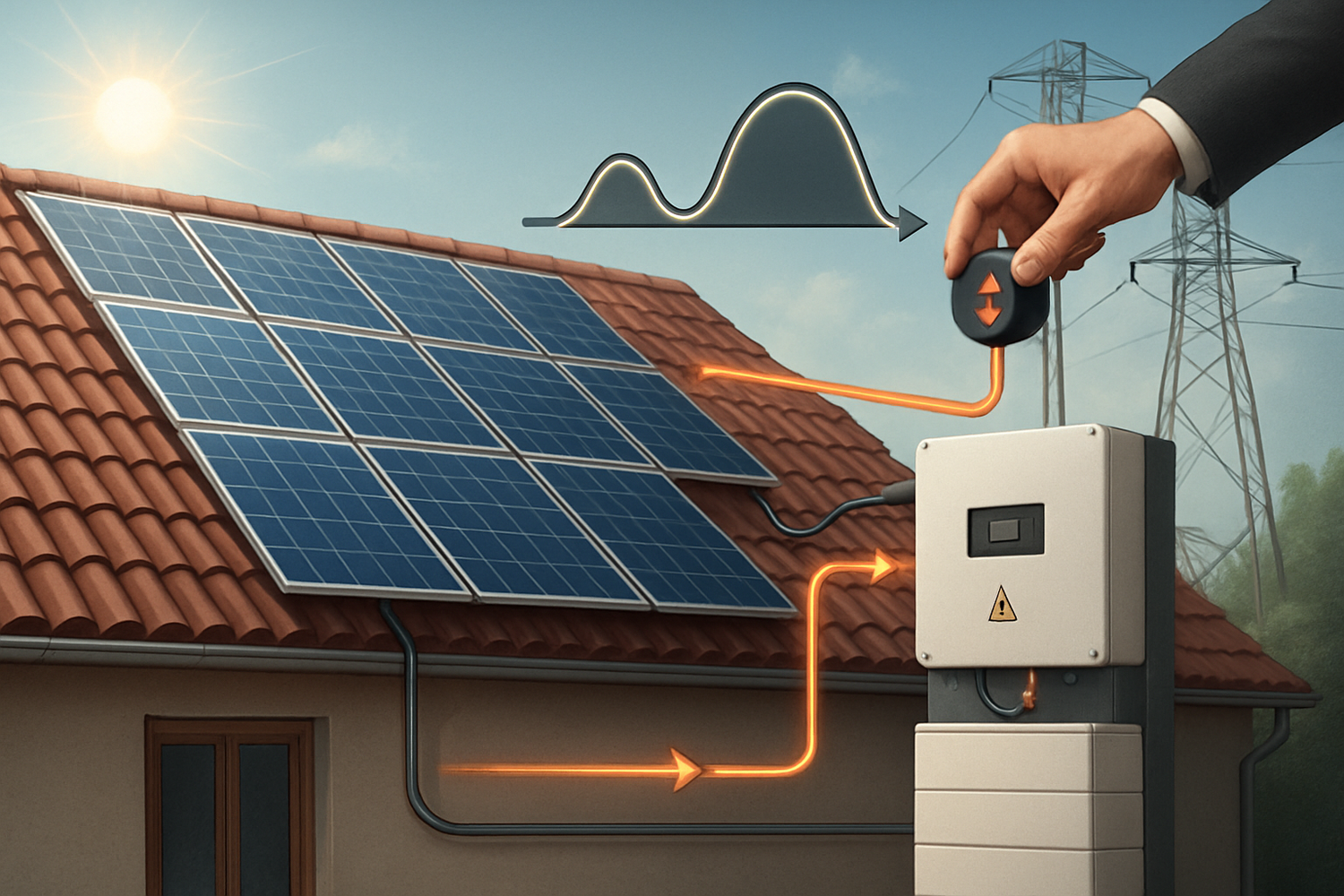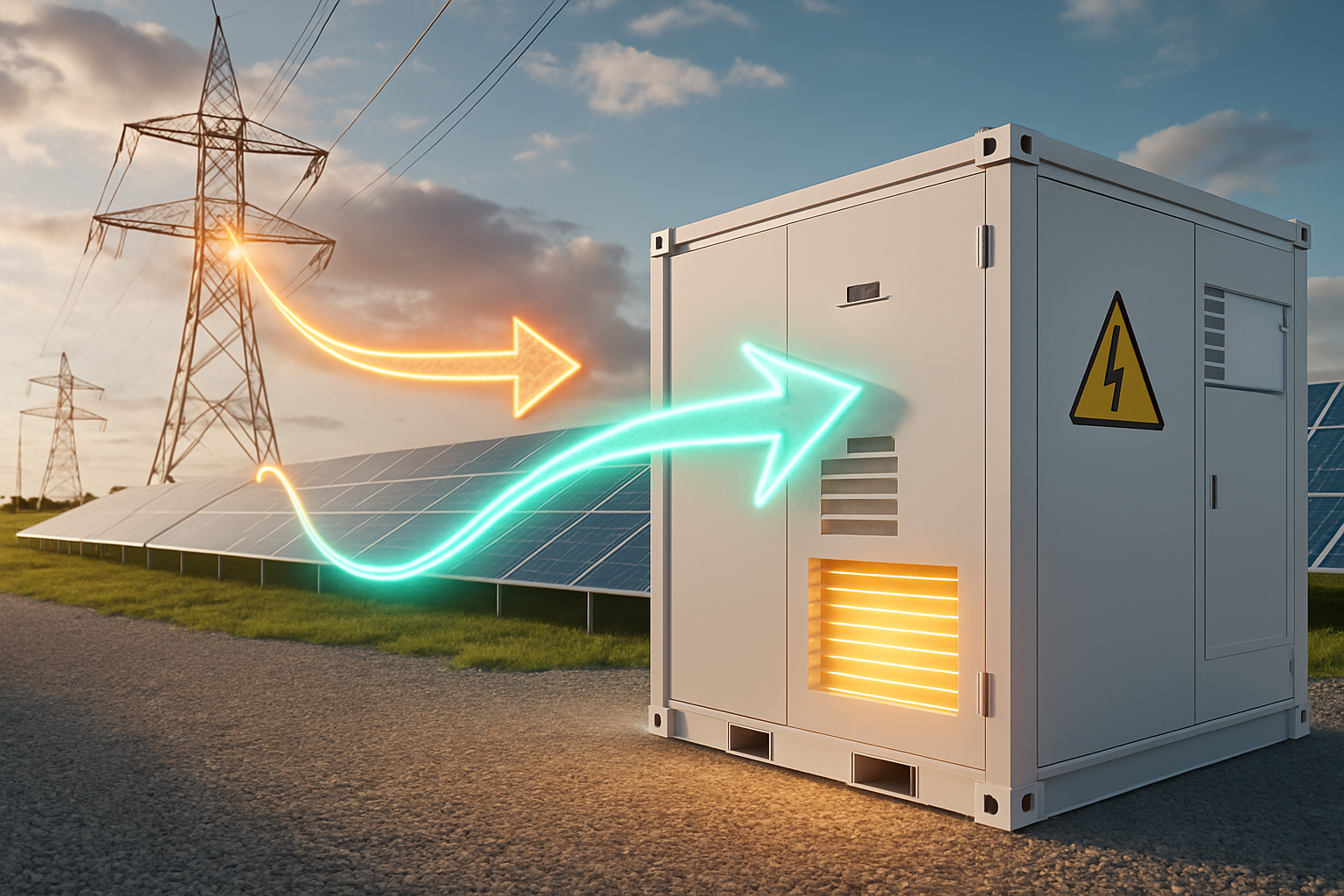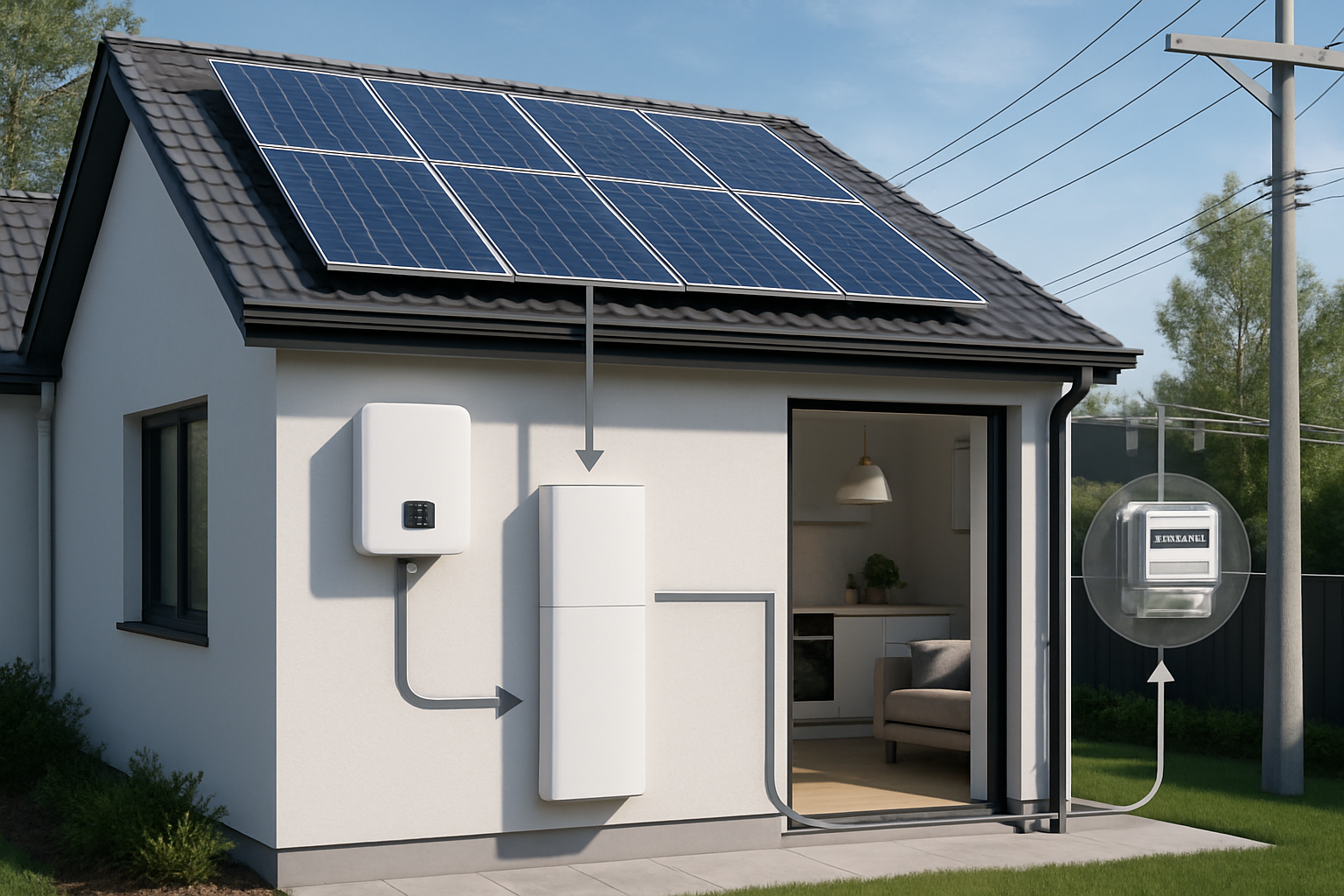
The journey toward energy independence often leads to solar power. You invest in a solar photovoltaic (PV) system, expecting consistent, clean energy. However, two terms frequently arise that can impact your system's performance and profitability: solar curtailment and inverter clipping. These phenomena, while distinct, both represent lost energy and potential revenue. Understanding them is crucial for maximizing your solar investment and ensuring efficient grid integration.
At ANERN, we bring years of experience in the solar and energy storage industry. We focus on manufacturing high-performance lithium batteries, developing comprehensive energy storage systems (ESS), and creating integrated solutions. Our goal is to provide reliable and scalable energy solutions, empowering you to achieve true energy independence. This article will guide you through the intricacies of solar curtailment and clipping, offering practical strategies and insights to manage them effectively.
Understanding Solar Curtailment
What is Solar Curtailment?
Solar curtailment refers to the deliberate reduction of a solar power plant's output below its potential capacity. Grid operators initiate this action to maintain grid stability and reliability. Think of it as a traffic controller temporarily closing a lane on a highway to prevent congestion. This is a common practice, especially as the penetration of variable renewable energy (VRE) sources like solar increases on the grid.
Causes of Curtailment
Several factors can lead to solar curtailment:
- Grid Congestion: The transmission and distribution lines have a finite capacity. When solar generation in a specific area exceeds the grid's ability to transmit that power, operators may curtail solar output to prevent overloads. This is particularly true for utility-scale VRE plants located far from demand centers.
- Oversupply: During periods of low demand and high solar generation (e.g., sunny afternoons on weekends), the total power injected into the grid can exceed consumption. To balance supply and demand, grid operators may reduce solar output. Operating high VRE power systems with some curtailment can be a cost-effective outcome.
- Grid Stability Issues: Solar power, being variable, can sometimes pose challenges to grid stability. Operators may curtail output to manage voltage fluctuations, frequency deviations, or other system imbalances. Familiarizing system operators with VRE technologies can reduce unnecessary curtailment.
- Regulatory Requirements: Some regions implement regulations that mandate curtailment. For instance, in Germany, small-scale PV systems (<30 kW) must either allow remote curtailment or permanently limit power injection to 70% of their rated AC capacity.
Impacts of Curtailment
The consequences of solar curtailment are significant for system owners:
- Revenue Loss: When your system is curtailed, you generate less electricity, directly impacting your financial returns from feed-in tariffs or energy sales.
- Reduced Return on Investment (ROI): Consistent curtailment extends the payback period of your solar investment.
- Energy Waste: Curtailed energy is clean energy that goes unused, undermining the environmental benefits of solar power.
For more insights into how home batteries can help, you may find this article helpful: How to cut PV curtailment with home batteries and hybrids.
Deciphering Inverter Clipping
What is Inverter Clipping?
Inverter clipping occurs when the DC power generated by your solar panels exceeds the maximum AC power output capacity of your solar inverter. The inverter, acting as a bottleneck, "clips" or limits the excess power, preventing it from being converted into usable AC electricity. Unlike curtailment, which is an external grid-driven action, clipping is an internal system limitation.
Causes of Clipping
Clipping is typically a result of system design choices:
- DC Oversizing: It is common practice to "oversize" the DC array (total panel wattage) relative to the inverter's AC rating. This ensures the inverter operates at or near its full capacity for longer periods, especially during less-than-ideal conditions (e.g., cloudy days, morning/evening). However, on peak sunny days, this oversizing can lead to clipping.
- Inverter Limitations: Every inverter has a maximum continuous AC output power. If the solar panels produce more DC power than the inverter can convert, the excess is clipped.
- High Irradiance and Low Temperatures: Solar panels perform better in cooler temperatures. On bright, cool days, panels can produce power exceeding their nameplate rating, increasing the likelihood of clipping.
To deepen your understanding of this topic, consider reading: Stop wasting sunshine: manage inverter clipping like a pro and 9 mistakes causing solar clipping—and how to fix each.
Clipping vs. Curtailment: Key Differences
While both result in lost solar energy, their origins differ:
| Feature | Solar Curtailment | Inverter Clipping |
|---|---|---|
| Cause | External (Grid operator, grid conditions, regulations) | Internal (System design, inverter capacity, DC oversizing) |
| Control | Beyond the system owner's direct control (unless storage is used) | Within the system designer's control |
| Purpose | Maintain grid stability, balance supply/demand | Optimize inverter utilization, extend peak production hours |
| Occurrence | Can happen at any time of high generation/low demand, or grid stress | Typically occurs during peak sun hours on ideal days |
Impacts of Clipping
Clipping primarily leads to:
- Energy Loss: The most direct impact is the loss of potential electricity generation.
- Reduced Efficiency: While strategic oversizing can be beneficial, excessive clipping means you are not fully utilizing your solar array's potential.
For a detailed analysis, explore: Data deep-dive: clipping losses vs DC oversizing payback.
Strategies for Curtailment and Clipping Management
Optimizing System Design
Careful planning can significantly reduce energy losses from both curtailment and clipping.
- Inverter Loading Ratio (ILR) Optimization: The ILR is the ratio of the DC array size to the inverter's AC rating. A well-chosen ILR balances maximizing inverter utilization with minimizing clipping losses. An optimal ILR varies based on location, panel orientation, and specific goals. The ultimate roadmap to inverter loading ratio and clipping
- Advanced Forecasting Tools: Accurate solar forecasting helps grid operators and system owners predict generation levels. This allows for better planning, reducing the need for sudden curtailment. Platforms like the Solar Forecast Arbiter analyze solar forecasts to help manage the amount of solar energy on the grid.
Energy Storage Solutions: Your Key to Control
Energy storage systems (ESS) are transformative tools for managing both curtailment and clipping. They offer a proactive solution, allowing you to capture and store excess solar energy instead of losing it.
- Mitigating Curtailment: When the grid signals for curtailment, an ESS can store the excess solar energy that would otherwise be wasted. This stored energy can then be used later when demand is high, or grid conditions allow, effectively "shifting" your solar output. This can help homeowners prevent PV curtailment. Q&A: What is PV curtailment, and can home ESS prevent it?
- Managing Clipping: During periods of peak production when your inverter would normally clip excess power, an ESS can divert that power into battery storage. This maximizes the energy harvested from your solar panels, rather than letting it go to waste.
- ANERN's Contribution: ANERN specializes in high-performance lithium iron phosphate (LiFePO4) batteries, known for their safety and reliability. Our home energy storage systems integrate these advanced batteries with hybrid inverters and solar panels, offering a complete solution. These systems enable you to store surplus solar energy for later use, reducing reliance on the grid and enhancing energy independence.
-
Benefits of Storage:
- Increased Self-Consumption: Use more of the solar power you generate, reducing your electricity bills.
- Grid Services and Revenue: Batteries can provide valuable services to the grid, such as frequency regulation and managing grid congestion, potentially creating new revenue streams. Unlock grid revenue: batteries easing congestion and curtailment
- Enhanced Energy Independence: Store energy for use during outages or at night, increasing your energy resilience.
Consider the benefits of PV curtailment vs. storage arbitrage for homeowners: PV curtailment vs storage arbitrage: what pays homeowners?
Advanced Inverter Functions
Modern solar inverters offer features that help manage power flow and grid interaction.
- Hybrid Inverters: These inverters combine the functions of a solar inverter and a battery inverter, allowing seamless integration of solar panels and battery storage. They are crucial for managing export limits and optimizing energy flow. Blueprint for export limits: hybrid inverters, MLPE, control
- Grid-Forming Capabilities: Advanced inverters with grid-forming capabilities can provide more system services, such as voltage formation, and help stabilize the grid, potentially reducing the need for curtailment. Future-ready: grid-forming hybrids to slash rooftop curtailment
- Active Power Management: Some inverters can actively manage their power output based on grid signals or local consumption, further aiding in curtailment avoidance.
Grid Integration and Policy
Effective management also involves understanding the broader energy landscape.
- Collaboration with Grid Operators: Improving communication and data sharing between solar plant operators and grid operators can lead to more efficient grid management and less unnecessary curtailment.
- Market Design and Compensation: Policy frameworks and market designs that properly compensate technologies for the value they provide to the system, beyond just energy, can incentivize solutions that reduce curtailment. This includes remuneration for services like frequency regulation and managing grid congestion.
- Grid Reinforcement: For utility-scale VRE, grid reinforcement and enhanced interconnection redundancy are often implemented to manage congestion and avoid curtailment.
Practical Implementation and ANERN's Role
Assessing Your System
How do you know if your system is experiencing curtailment or clipping? Monitoring your system's performance data is key. Look for periods where your actual output is significantly lower than the theoretical maximum for the given weather conditions. Clipping often appears as a flattened curve at the peak of your daily production graph.
ANERN's Integrated Solutions
At ANERN, we focus on delivering reliable and scalable energy solutions. Our extensive experience in the solar industry allows us to understand these challenges deeply and provide effective answers.
- Lithium Iron Phosphate Batteries (LiFePO4): Our LiFePO4 batteries are at the core of our storage solutions. They offer superior performance, exceptional safety, and a long cycle life, making them ideal for capturing and deploying excess solar energy.
- Home Energy Storage Systems (ESS): Our integrated ESS solutions combine our high-quality lithium batteries with advanced hybrid inverters and solar panels. These systems are designed to maximize self-consumption, provide backup power, and actively manage both curtailment and clipping. Whether you need a robust system for your home or a comprehensive solution for a farm or cabin, our off-grid solar solutions offer the energy independence you seek.
- Solar Inverters: ANERN's solar inverters efficiently convert DC electricity from your panels into usable AC power. Our hybrid inverters are particularly adept at managing power flow between solar, batteries, and the grid, optimizing your energy usage and minimizing losses.
By choosing ANERN, you partner with a company dedicated to helping you achieve energy independence through advanced, reliable, and integrated solar and storage technologies.
Key Takeaways
Solar curtailment and inverter clipping are inherent challenges in the expanding solar energy landscape. While they represent lost energy, effective management strategies exist. Understanding the distinct causes and impacts of each phenomenon allows you to implement targeted solutions.
Optimizing system design, leveraging advanced forecasting, and crucially, integrating energy storage solutions are paramount. Technologies like ANERN's high-performance lithium iron phosphate batteries and integrated home energy storage systems offer powerful tools to capture otherwise wasted energy, enhance grid reliability, and move you closer to complete energy independence. Proactive management of these issues ensures you maximize your solar investment and contribute to a more resilient and sustainable energy future.
Non-Legal Disclaimer
The information provided in this article is for general informational purposes only and does not constitute legal, financial, or investment advice. Always consult with qualified professionals before making any decisions related to energy systems, investments, or legal matters.
References
- IEA. (2010). Technology Roadmap - Solar Photovoltaic Energy 2010. Retrieved from https://www.iea.org/reports/technology-roadmap-solar-photovoltaic-energy-2010
- OECD/IEA. (2018). System Integration of Renewables: An Update on Best Practice. Retrieved from https://www.iea.org/reports/system-integration-of-renewables
- IEA. (2024). Integrating Solar and Wind - Chapter 2. Global experience. Retrieved from https://www.iea.org/reports/integrating-solar-and-wind
- IEA. (2024). Integrating Solar and Wind - Chapter 4. Policy action Global experience and emerging challenges. Retrieved from https://www.iea.org/reports/integrating-solar-and-wind
- IEA. (2024). Integrating Solar and Wind. Retrieved from https://www.iea.org/reports/integrating-solar-and-wind
- U.S. Department of Energy, Office of Energy Efficiency & Renewable Energy. (2022, May 23). EERE Success Story—Solar Forecasting Platform Helps Grid Operators Plan Energy Mix. Retrieved from https://www.energy.gov/eere/articles/eere-success-story-solar-forecasting-platform-helps-grid-operators-plan-energy-mix
- IEA. (2024). Integrating Solar and Wind. Retrieved from https://www.iea.org/reports/integrating-solar-and-wind
- IEA. (2018). System Integration of Renewables. Retrieved from https://www.iea.org/reports/system-integration-of-renewables
- IEA. (2024). Integrating Solar and Wind. Retrieved from https://www.iea.org/reports/integrating-solar-and-wind





Leave a comment
All comments are moderated before being published.
This site is protected by hCaptcha and the hCaptcha Privacy Policy and Terms of Service apply.